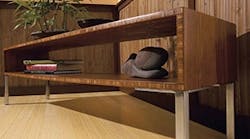Interior designers and architects are facing escalating pressures from clients and the public to make informed decisions about the interior furnishings and building materials they specify. At issue is the impact of these products on the quality of indoor air.
Among the chemicals widely recognized as contributing to poor indoor air quality is formaldehyde, which was officially designated a known human carcinogen by the U.S. government in mid-2011. What is particularly troublesome for the A&D community is the fact that the government report expressed specific concerns about formaldehyde emissions from wood-bonding adhesives used in manufactured wood products, such as furniture and flooring, as well as construction products like particleboard, fiberboard and hardwood plywood.
indoor air quality in schools
While air quality is a concern in all indoor environments, a “poster child” for this issue is emerging. Attention is increasingly focused on the quality of air in academic environments. Studies show that more than 50,000 elementary and secondary schools in the United States have indoor air quality issues, according to the Environmental Protection Agency.
Considering the millions of students, faculty and administrators housed in these buildings, the impact of poor air quality is far-reaching. Parents, elected officials and the public are expressing concerns about both the susceptibility of children to pollutants and the well-being of faculty and others who spend time in these schools. The impact of polluted air on academic achievement at a time when educational excellence is so important is also being questioned.
Concerned administrators in some school districts have gone so far as to develop “black” or “red” lists of chemicals that are not allowed in products used to construct or furnish their schools. Formaldehyde is conspicuously present on virtually all of these lists.
Interior designers and architects involved in school projects often find themselves pulled in opposite directions. Doing the right thing in terms of indoor air quality is a given for virtually all of them.
However, that’s often easier said than done. The research needed to separate the facts from fiction regarding formaldehyde-emitting adhesives can be time-consuming and confusing, due to the arcane terminology used by the adhesives industry and a general lack of transparency. Furthermore, many cash-strapped school districts may not want to pay for the additional research to find suitable substitutes for formaldehyde-emitting cabinets, desks, tables and doors. PageBreak
the new range of adhesives
The lives of designers and architects can be much simpler, and their research more efficient and effective, if they are knowledgeable about the range of formaldehyde-emitting adhesive systems currently used to make manufactured wood products.
At one end of the spectrum are adhesives which do not contain formaldehyde, and therefore cannot release it into the environment. Called no-added-formaldehyde (NAF) adhesives, they are rapidly gaining market share.
The latest breakthrough in NAF adhesives are systems made from soy flour and a proprietary resin. These adhesives perform as well or better than others on the market and can be substituted easily during the manufacturing process for formaldehyde-emitting adhesives.
Manufactured wood products made with any NAF adhesive will qualify for points under LEED. Those adhesives will also pass all of the global formaldehyde emission regulations for wood products. Specifying an NAF adhesive ensures the lowest level of formaldehyde content for any type of product.
In the middle of the spectrum of wood-bonding agents are no-added-urea-formaldehyde (NAUF) adhesives. These systems contain and emit less formaldehyde into the environment than other formaldehyde-based adhesives. Unfortunately, the term “no-added-urea-formaldehyde” is often misinterpreted to mean there is no formaldehyde of any kind in the adhesive. In fact, these adhesives typically contain either phenol-formaldehyde or melamine-formaldehyde.
Wood products made with NAUF adhesives can help a project qualify for points under LEED because they are considered to be lower emitting than those containing urea-formaldehyde (UF).
UF-based adhesives add the most formaldehyde to engineered woods and, accordingly, emit more formaldehyde than any other system. UF-based adhesives are the most widely used today, likely because they perform well and cost the least.
Some furniture and flooring manufacturers whose products contain UF adhesives cite cost as a reason for not switching to woods manufactured with NAF adhesive systems. However, cost is relative. NAF adhesives are estimated to increase the cost of many finished products by less than 10 percent. For many, this is a small price to pay for the peace of mind of knowing that the adhesives in the furniture and flooring in their homes, schools and offices do not emit formaldehyde—a designated carcinogen.
UF-based adhesives do not qualify a project for points under LEED. In addition, regulators around the world have focused on UF-based adhesives, with those in the United States being particularly aggressive.
ask the right questions
Learning the facts about formaldehyde emissions from specific brands of furniture and flooring made with decorative plywood, wood composites and engineered wood can be challenging. But interior designers and architects can get factual information about a specific brand by asking the manufacturer three basic questions:
- Are the decorative plywoods, wood composites and engineered woods used in your products made with no-added formaldehyde (NAF) adhesives?
- Are your finished products independently certified to be LEED compliant by an organization like the GREENGUARD Environmental Institute or Floorscore?
- Do your finished products meet the California Air Resources Board’s standards for ultra-low-emitting formaldehyde (ULEF), the lowest level of emissions?
Manufacturers committed to creating products that contribute to healthier air quality in schools and other indoor environments will answer “yes” to each question. And, armed with the facts, designers and architects can ease client concerns and be confident about the air quality impact of the engineered wood products they specify.
Dr. Melinda Burn is Global Business Director—Sustainable Building and Construction with Ashland Inc., manufacturer of Soyad™ adhesives. She can be reached at [email protected].
